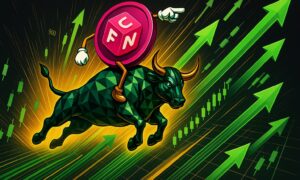
In recent years, the iGaming and Web3 space has been buzzing with promises: blockchain, tokens, and player-driven economies reshaping how people play and interact. From play-to-earn mechanics to the rise of crypto-friendly casinos, the sector has positioned itself as one of the most dynamic in the decentralized economy.
But innovation, as it turns out, is often more aesthetic than structural.
“If all you’ve done is add a token to a model that still relies on new players entering to survive, you haven’t reinvented anything. You’ve just tokenized fragility.” — Zak Manhire, CEO of Mint
For Zak and others taking a more critical look at the market, the challenge isn’t launching a token — it’s building an economic system with real utility, sustainable value flow, and long-term user trust. While projections put the blockchain gaming industry at over $259 billion by 2032, user engagement isn’t keeping pace. In fact, daily active wallets in the space declined to 4.66 million in Q3 2025 — highlighting a widening gap between market hype and user retention.
That gap often stems from how tokens are positioned. On paper, they promise access, empowerment, and decentralized engagement. In practice, many become speculative tools without genuine in-platform utility. Zak puts it bluntly:
“An economy without real utility is just a machine for inflating expectations. At Mint, we’ve designed our token to be a tool for enhancing the user experience — not the reason people show up in the first place.”
Serious platforms, he says, should be able to clearly answer a few simple questions: What does the token actually do inside the ecosystem? Is most of the platform’s revenue coming from gameplay or from speculation? Is the token supply managed transparently, with clear distribution, burn mechanics, and fair vesting? When those answers are vague — or conveniently avoided — the token becomes a liability instead of a foundation.
Beyond token design, there’s another layer of complexity that most platforms struggle to address: the increasingly blurry line between entertainment, gambling, and investment. In some projects, what starts as a game quickly becomes a speculative instrument. Users shift from playing “for fun” to calculating returns — often without fully understanding the risks.
Zak believes that distinction must be made explicit, not just internally, but in how the product communicates with users.
“You can’t expect users to understand risk if you haven’t explained it transparently. Platforms need to draw a clear line between game mechanics, reward dynamics, and financial exposure — and they need to communicate that well.”
At Mint, this philosophy is built into how the experience is structured. The platform ensures that users always know whether they’re engaging in gameplay or placing bets, and what those actions imply.
“Clarity protects trust — and trust sustains the ecosystem,” Zak says.
That sense of clarity is also missing from another common industry trope: the so-called “crypto casino.” While the label is everywhere, it rarely reflects any real shift in how these platforms operate. Most simply accept USDT or another cryptocurrency as a payment method, while maintaining the same opaque economic logic underneath.
For Zak, that’s not innovation — it’s a distraction.
“Accepting USDT doesn’t make you Web3. What transforms the experience is rebuilding the economic architecture transparently, with verifiable systems and clear user alignment.”
That means using smart contracts to govern logic, publishing provably fair game data, embedding utility into the economy beyond just speculation, and giving users a voice in how platforms evolve.
Under Zak’s leadership, Mint has focused on responsible development across several dimensions: transparency around tokenomics and smart contracts, utility that adds real value to gameplay and the player journey, tools for user protection, and real compliance with regulated jurisdictions. Importantly, the platform takes care to clearly differentiate between gaming and wagering — avoiding the ambiguity that has led other projects into regulatory gray zones or user backlash.
The promise of blockchain and Web3 in gaming is real — but without structural integrity, user understanding, and long-term thinking, it quickly devolves into marketing jargon. As Zak puts it:
“Web3 can’t be an excuse to repeat Web2’s mistakes with new words. If we’re going to build something new, let’s actually build something better.”
That difference — between promising a revolution and delivering one — is what will separate the platforms that define the next decade from those that disappear by the end of the quarter.


































